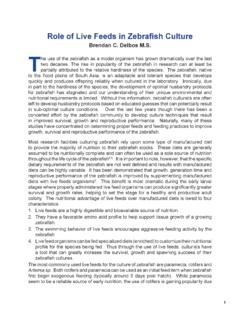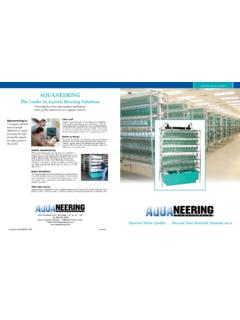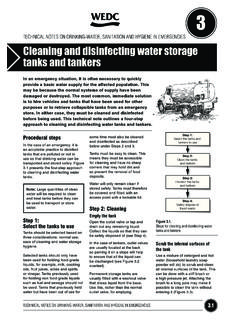Transcription of Fluidized Bed Biofiltration Technology For …
1 Sam CourtlandAquaneering, Clairemont Mesa #117 San Diego, California 92107 USATel: aquaculture industry is moving rapidly towards re-circulating systems for improved biosecurity, moreefficient heating and cooling, reduced pumping costs,and more stable water quality. This shift requires an in-creased awareness of the filtration equipment needed to at-tain the intended water quality in the most economical design criteria and management techniques mustalso be considered when implementing recirculation. Thisarticle discusses general recirculating system design andmanagement considerations, with special emphasis on flu-idized bed biofilter Technology and its applications in aqua-culture systems that demand high water quality. Fluidized Bed Biofiltration Technology For Oligotrophic water Quality When designing a recirculating system it is essential toconsider the most cost effective filtration system for the de-sired water quality.
2 For oligotrophic (low nutrient levels)systems, where extremely high water quality must be at-tained, biofilters with low cost per cubic foot of media andhigh surface area per unit volume must be considered. This iswhere Fluidized bed filters really stand apart from other filters. The fine sand media in a Fluidized bed biofilter providesan extremely high surface area (7,800 ft2/ft3) and acts as athin film reactor. This enables the biofilter to remove up to100% of the ammonia per pass and allows the system to beshock-loaded without any changes in overall water addition to nitrification, between 200 and 1000 differentbacteria species can flourish in the sand media, whichkeeps water in the system biologically mechanical filter must be used in series before thefluidized bed biofilters, to remove the suspended solids andmaximize performance of the Fluidized bed.
3 A propellerwashed bead filter is recommended for this application, be-cause of its effectiveness in removing particles down to 15 in size as well as low water discharge during the nitrification process requires two ppm of oxy-gen for every one ppm of ammonia removed, we must in-clude aeration in our recirculating system design. Re-satu-ration of oxygen as well as off gassing of CO2can be accom-plished in a single pass through a packed column. Thepacked column can be placed at the exit of the Fluidized bedfiltration system, which will require no additional energy or expensive sterilization and disinfecting equipment, such as aUV (ultraviolet) sterilizer and a protein skimmer, can beused in a recirculating system to further improve the quali-ty and clarity of the water . This equipment would be usedmost efficiently after the water has passed through the fil-tration Applications for Fluidized Bed Biofiltration SystemsFluidized bed Biofiltration systems have proven verysuccessful at maintaining excellent water quality for a num-ber of different aquaculture applications.
4 These applicationsinclude penaeid shrimp hatcheries, fish breeding centers,zebra fish genetics research laboratories, koi ponds, andseafood holding need for increased biosecurity and rising shrimpprices due to recent outbreaks of white spot virus havesparked particular interest in recirculation Technology in allphases of the shrimp hatchery. Shrimp maturation andbroodstock growout designs have been developed and arecurrently being used successfully. These systems can uti-lize water exchange rates of less than 2% per day, whichenables incoming water to be treated and greatly decreasesFluidized bed biological filter with a flow rate of 15 l/sec(200 gal/min). Fluidized Bed Biofiltration Technology For Oligotrophic water Quality18 THE ADVOCATEJUNE 2000the risks of pathogen introduction and disease in water quality due to red tides, rainfall, andagricultural runoff are also greatly reduced.
5 Improved sta-bility in water quality in commercial shrimp maturationsystems has resulted in increased production. In some cases,ovarian maturation now occurs without eyestalk next step is development of recirculating systems forlarviculture. This research is currently underway and awaitscommercial testing. Recirculating System Design and ManagementThe implementation of this new Technology requirescareful design and management. The new system must beproperly sized for the desired water quality, taking into con-sideration the total water volume, daily feed rates, and bio-mass in the tanks. The flow rate should allow the water topass through the filtration system every three hours in orderto eliminate ammonia completely each pass. The system itself should be designed to allow biologiststo work with the animals without added constraints.
6 For ex-ample, plumbing should allow for medicating, draining,and cleaning of tanks without interfering with the rest of thesystem. The water discharge from these operations must bediverted to the waste drain and not sent to the integrating a recirculating system into an existingflow-through system, careful design must also allow theflexibility of using either flow diagram should be designed efficiently byusing gravity to move water whenever possible, and forease of operation and maintenance. Valves should be eitheropen or shut and not adjusted by operators to balance flowrates. Additionally, the system should rely on mechanicaloperation, not electronics, to control water levels in thesump tanks. It is also very important to the success of the system toanticipate problems before they occur.
7 For example, a sta-ble electrical supply and a backup generator are very im-portant to keep the system running. Sump tanks must notonly be sized properly for operation, but also for dynamichead in case of a power outage. If the dynamic head is nottaken into consideration, the tanks may flood the room andburn a pump when the system starts back up. Sump tanksmust also be designed with overflows to allow tanks to betaken off line when systems also need to be managed careful-ly for optimum performance. This will require regularbackwashing of filters and routine checking of sand andsump tank levels. A complete maintenance log must be keptup to date. Regular testing of ammonia, nitrite, and pH isalso required. In commercial hatcheries, a dedicated, waterquality manager may be needed to keep careful records andmake important system management decisions.
8 ConclusionFluidized bed Biofiltration systems have successfullyprovided consistent, high quality water for a number of dif-ferent aquaculture applications, such as shrimp maturationsystems. With the anticipated development of recirculatingsystems for larval rearing, shrimp hatcheries may soon be-come independent of ocean-front sites. An awareness of thecareful balance that exists in a recirculating system, cou-pled with sound design and proper management, is neededto keep the system running without fail for many years. Theinitial capital investment in Fluidized bed recirculation sys-tems may seem high, but it is a proven, long term, and sus-tainable solution for aquaculture systems that demand highwater Fluidized bed filter system for shrimp ADVOCATEJUNE 200019







